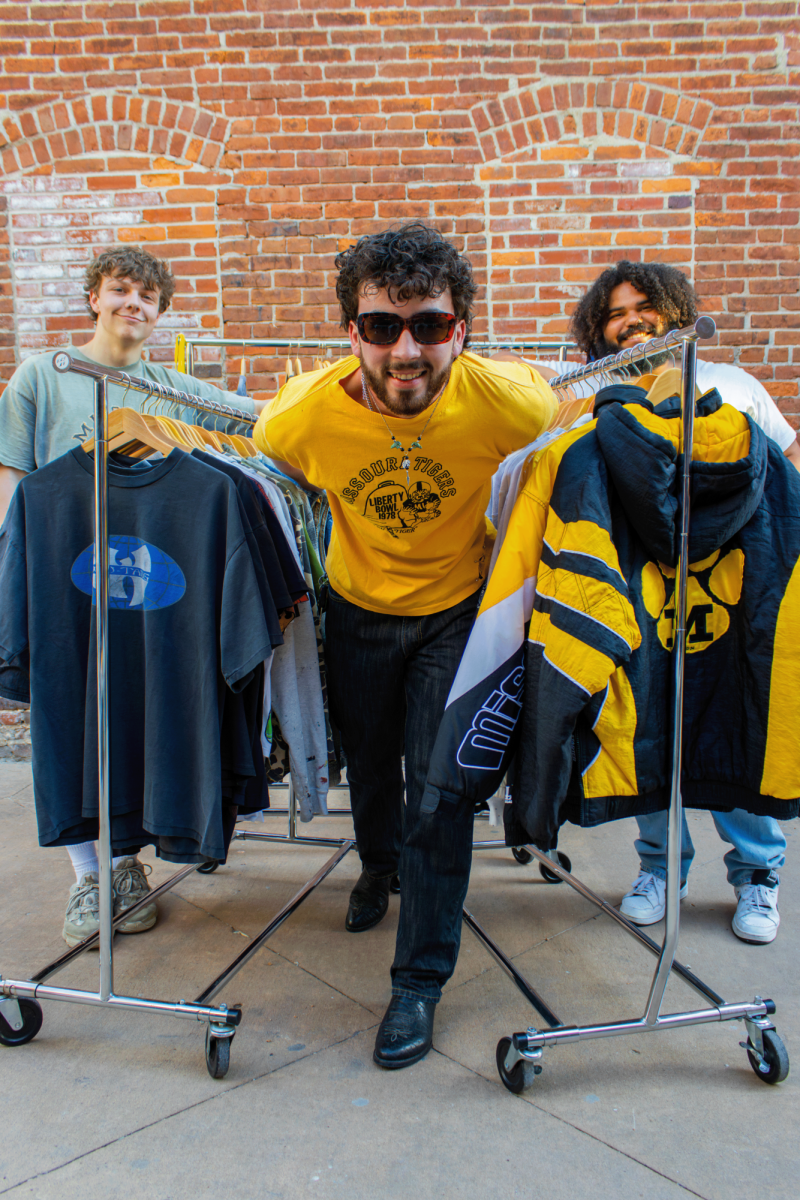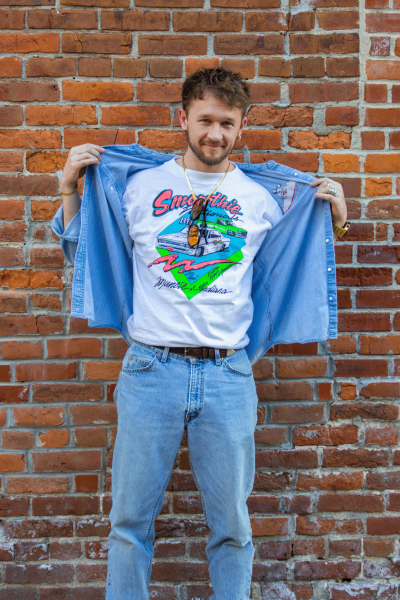
Jack Andersen
Walking through the University of Missouri’s campus, it’s common to see vintage sellers gathering in Speakers Circle or lining Lowry Mall. Many students and local residents sell vintage items to MU students.
With pop-ups selling old-school MU merch, ‘80s sweaters, Y2K fashion and everything in between, there are items to suit nearly every style. The diverse mix of sellers only adds to the clothing’s appeal.
Some sellers in the area, such as Kyle Gilleland of Lou Vintage, consider their vintage businesses their primary job. However, many sellers on campus are students as well, balancing their business pursuits with academics. Alana Osborne of Alana’s Archives is a textile and apparel management major, which has grown her love for clothing and brought her closer to others who care about it.
“I’m surrounded by this community where we all care about vintage clothes. So, I guess it’s just super supportive,” Osborne said.
Other student sellers have degrees unrelated to the fashion world. Gabe Watkins-Mocumbi of Gabe’s Grabs, Aaron Volk of Undr Skn and Scott Ahern of Mizarket are all pursuing degrees in science-related fields including biology, nursing and industrial engineering. For many, selling vintage clothing acts as an outlet for self expression.
“I’m trying to find that work-life balance of making sure I’m here for my Plan A, which is my career and my major, but also trying to keep that hobby alive, because it allows me to do something that I really do enjoy,” Volk said.
The process of developing these businesses can be unpredictable. While the sellers have owned their businesses for varying amounts of time, many began to develop the passion for secondhand clothing when they were young. For Watkins-Mocumbi, this passion developed while trying to find unique items at low prices when he would shop at Goodwill with his mom while growing up. He often watched YouTube videos from those with vintage business expertise, further sparking a desire to work in this area.
Ahern similarly turned to thrift stores to develop his style without paying high prices.
“I started with sneakers back in like seventh, sixth grade. When there was drops on Nike, I would enter the draw, hoping to get picked to resell them,” Ahern said. “I had these cool sneakers, but I necessarily wasn’t able to afford the cool clothes with the sneakers, so then I started thrifting.”

Sourcing for items varies depending on the seller, but most acquire their items through thrift stores, estate sales and donations. Through these purchases, vintage sellers can prevent a number of high quality items from being discarded and encourage the reuse of pieces for years.
There is also a large sense of appreciation for the vintage clothing retail community among sellers. Many got their start by working pop-ups with existing sellers and have made close friends with those they sell alongside. While there is some competition, most are encouraging and supportive. Volk has seen this echoed in the vintage selling community.
“Everyone I’ve met in this community, you know, there’s a few bad apples here and there, but everyone’s really genuine,” Volk said. “At the end of the day, they’re in it for the history of just clothing and kind of bring that idea of secondhand clothing and how it’s pretty good for the environment.”
For many, the story behind the pieces is just as important. Hearing the stories of people who previously owned items they resell is a special experience for many sellers.
“You have these stories and these people attached to these clothes you’re finding, that has always meant a lot to me,” Ahern said.
While some hear directly from previous owners, others are left to consider the unknown person who once wore these pieces.
“They had a whole life that they lived before I even wore this item,” Gilleland said. “I wonder if this was something that they wore on their first date with the person that they married, or their first kiss, or like the day they got an A on a test or something like that.”
The opportunity to share these stories with a larger audience occurs through multiple mediums and methods. While these sellers do not have brick-and-mortar stores, they offer in-person sales through pop-ups and vintage festivals. For many sellers, one appeal of in-person events is the growth of connection with buyers.
“I actually really enjoy talking to people about a shared love,” Watkins-Mocumbi said. “I always used to say that I find you favorites.”
The majority of sellers also use social media platforms like Instagram to share photos of their items, advertise upcoming events and even facilitate sales. Another aspect of social media platforms is their ability to help sellers connect with others who share their interests.
“Probably one of the most rewarding things is getting to talk to people that are also into it,” Volk said. “You can talk to anyone from anywhere, and there’s people from out of the country that I’ve talked to about vintage.”
Digital platforms offer an additional way to sell during the winter months when in-person events are less feasible. For Ahern and Gilleland, their personal websites assist in accruing more sales in these cases. Osborne specializes in selling on the secondhand clothing site Depop. Osborne said her shop is typically geared towards women, with her shop featuring selections of brightly colored or textured dresses and with shoes being staples of her collection.
A major goal for sellers who primarily target college students is to keep items affordable while still making a profit. They research the history of pieces to ensure they assign them an appropriate value. However, many sellers encourage buyers to discuss pricing.
“If there’s anything absolutely out of your comfort zone, just give me an alternative option,” Osborne said. “I’m totally open here with different prices.”
Volk appreciates the ways that price negotiation can help his buyers.
“I don’t put price tags on any of my stuff because I like people to learn to bargain and negotiate,” Volk said. “Not only are you just buying something, but you’re learning a skill that could definitely help you in the future, maybe buying a house, buying a car, those all have bartering in it.”
As the sellers look to the future, many are hopeful about expanding their businesses, with dreams of creating brick-and-mortar storefronts. Others consider continuing to sell vintage as a side job or hobby while pursuing careers related to their academic pursuits.

However, there are some reservations as well. Concerns have arisen regarding the recent trend of secondhand shopping in a world of fast fashion. As vintage gets more popular, some sellers question the longevity of the industry.
“I think it’ll stay in culture forever, but I’m not so short sighted as to say that it couldn’t just completely give out from under itself the next couple days,” Watkins-Mocumbi said.
Vintage selling has become a major force in the world of fashion and a popular way for individuals to show their sense of style. While the future may not always be certain, local sellers continue to cultivate a community for buying and selling clothing with a deeper meaning.
Edited by Molly Levine | [email protected]
Copyedited by Alana Sheba and Ava Mohror | [email protected]
Edited by Annie Goodykoontz | [email protected]